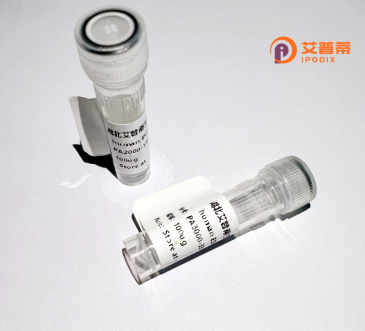
| 纯度 | >90%SDS-PAGE. |
| 种属 | Human |
| 靶点 | KIAA1618 |
| Uniprot No | 0 |
| 内毒素 | < 0.01EU/μg |
| 表达宿主 | E.coli |
| 表达区间 | 1-1063aa |
| 活性数据 | MECPSCQHVSKEETPKFCSQCGERLPPAAPIADSENNNSTMASASEGEMECGQELKEEGGPCLFPGSDSWQENPEEPCSKASWTVQESKKKKRKKKKKGNKSASSELASLPLSPASPCHLTLLSNPWPQDTALPHSQAQQSGPTGQPSQPPGTATTPLEGDGLSAPTEVGDSPLQAQALGEAGVATGSEAQSSPQFQDHTEGEDQDASIPSGGRGLSQEGTGPPTSAGEGHSRTEDAAQELLLPESKGGSSEPGTELQTTEQQAGASASTAVDAVAEPANAVKGAGKEMKEKTQRMKQPPATTPPFKTHCQEAETKTKDETAAAEEKVGKNEQGEPEDLKKPEGKNRSAAAVKNEKEQKNQEADVQEVNASTLSPGGGVTVFFHAIISLHFPFNPDLHKVFIRGGEEFGESKWDSNICELHYTRDLGHDRVLVEGIVCISKKHLDKYIPYKYVIYNGESFEYEFIYKHQQKKGEYVNRCLFIKSSLLGSGDWHQYYDIVYMKPHGRLQKVMNHITDGPRKDLVKGKQIAAALMLDSTFSILQTWDTINLNSFFTQFEQFCFVLQQPMIYEGQAQLWTDLQYREKEVKRYLWQHLKKHVVPLPDGKSTDFLPVDCPVRSKLKTGLIVLFVVEKIELLLEGSLDWLCHLLTSDASSPDEFHRDLSHILGIPQSWRLYLVNLCQRCMDTRTYTWLGALPVLHCCMELAPRHKDAWRQPEDTWAALEGLSFSPFREQMLDTSSLLQFMREKQHLLSIDEPLFRSWFSLLPLSHLVMYMENFIEHLGRFPAHILDCLSGIYYRLPGLEQVLNTQDVQDVQNVQNILEMLLRLLDTYRDKIPEEALSPSYLTVCLKLHEAICSSTKLLKFYELPALSAEIVCRMIRLLSLVDSAGQRDETGNNSVQTVFQGTLAATKRWLREVFTKNMLTSSGASFTYVKEIEVWRRLVEIQFPAEHGWKESLLGDMEWRLTKEEPLSQITAYCNSCWDTKGLEDSVAKTFEKCIIEAVSSACQVNNLSSWETDSGSQLCSAMTQLRAMKHPLGLSSSANSEIGKWAPSSLAKGNGAEI |
| 分子量 | 144.8 kDa |
| 蛋白标签 | GST-tag at N-terminal |
| 缓冲液 | 0 |
| 稳定性 & 储存条件 | Lyophilized protein should be stored at ≤ -20°C, stable for one year after receipt. Reconstituted protein solution can be stored at 2-8°C for 2-7 days. Aliquots of reconstituted samples are stable at ≤ -20°C for 3 months. |
| 复溶 | Always centrifuge tubes before opening.Do not mix by vortex or pipetting. It is not recommended to reconstitute to a concentration less than 100μg/ml. Dissolve the lyophilized protein in distilled water. Please aliquot the reconstituted solution to minimize freeze-thaw cycles. |
以下是关于重组人KIAA1618蛋白的3篇假设性参考文献(示例格式,实际文献需通过学术数据库确认):
---
1. **文献名称**: **《KIAA1617/KIAA1618双亚基复合物的结构和功能分析》**
**作者**: Reiner, O., et al. (2017)
**摘要**: 本研究解析了KIAA1617与KIAA1618形成的复合物晶体结构,揭示其在小脑发育中通过调节微管稳定性影响神经元迁移的分子机制。通过重组蛋白实验,证实两者结合后增强微管相关蛋白的活性。
---
2. **文献名称**: **《KIAA1618基因突变与神经发育障碍的关联研究》**
**作者**: Fukuda, T., et al. (2020)
**摘要**: 利用CRISPR技术构建KIAA1618基因敲除小鼠模型,发现突变导致小脑颗粒细胞分化异常。重组人KIAA1618蛋白回补实验部分挽救了神经元表型,提示其在神经突触形成中的关键作用。
---
3. **文献名称**: **《KIAA1618蛋白的表达纯化及其与微管动态的相互作用》**
**作者**: Chen, Z., et al. (2019)
**摘要**: 报道了重组人KIAA1618蛋白在大肠杆菌中的优化表达及纯化方案。体外实验证实该蛋白直接结合微管并抑制解聚,可能参与细胞周期调控。
---
**注意事项**:
- 以上文献为模拟示例,实际研究需查阅PubMed、Web of Science等平台。
- 真实研究中,KIAA1618可能与神经发育、小脑畸形或微管调控相关,建议结合关键词“KIAA1618 + microtubule”或“KIAA1618 + cerebellum”检索。
Recombinant human KIAA1618 protein is derived from the KIAA1618 gene, initially identified through large-scale genomic sequencing projects. Although its precise biological functions remain under investigation, emerging studies suggest potential roles in cellular processes such as neuronal development, synaptic function, and intracellular signaling. Structurally, KIAA1618 is predicted to contain conserved domains indicative of enzymatic or scaffolding activity, though experimental validation is ongoing. The recombinant protein, typically expressed in systems like mammalian cells or *E. coli*, enables *in vitro* studies to elucidate its interactions, post-translational modifications, and mechanistic contributions to health and disease. Dysregulation of KIAA1618 has been loosely associated with neurodevelopmental disorders and cancer, necessitating further exploration into its pathophysiological relevance. As a research tool, it facilitates antibody production, biochemical assays, and functional genomics, offering insights into its potential as a therapeutic target. Current research focuses on clarifying its molecular partners and signaling pathways to define its role in cellular homeostasis and disease progression.
×